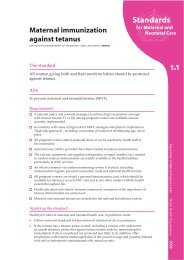1uvZ4zN
1uvZ4zN
1uvZ4zN
You also want an ePaper? Increase the reach of your titles
YUMPU automatically turns print PDFs into web optimized ePapers that Google loves.
Volume III<br />
Chapter ONE<br />
characteristically displayed ethnic, cultural, and linguistic homogeneity, as well as<br />
fundamental cohesion.<br />
17. Foreign intrusion – notably slave trade and colonialism – led to the decline<br />
and subsequent demise of many of the social and communal values that had<br />
defined African societies. With the introduction of Arab slave traders and<br />
European colonialists, African customary practices that essentially promoted<br />
homogeneity no longer evolved according to African needs.<br />
18. The weapons of Africans at the time (spears, bows, and arrows) were inadequate<br />
against the more destructive weapons of the foreign intruders. Consequently,<br />
African societies were easily dominated politically, economically, and socially and<br />
their social structures and cultures were either ignored or replaced with foreign ones.<br />
For the administrative convenience of the colonial rulers, the disparate traditional<br />
communities were forcibly cobbled together to form a single large territorial entity.<br />
It was in this fashion that most of the colonial African states, including Kenya, were<br />
formed and developed over the years.<br />
Divide and rule policy<br />
19. The colonial government pursued a policy of ‘divide and rule’ in order to consolidate<br />
their hold on the country, and to lessen the possibility that the African population<br />
would resist colonial rule. To that end, they magnified the differences between the<br />
various communities and regions, and stereotyped each community in a manner<br />
that would sow suspicion, hatred and the sense of ‘otherness’.<br />
20. In addition, colonial government created ethnically defined administrative boundaries.<br />
In determining such boundaries, no serious thought, if at all, was given to historical<br />
inter-ethnic interactions and relations. For instance, the people of what was known<br />
as Northern Frontier District were divided into two main groups: Somali and Galla<br />
with each group accorded its own territory. Sub-groups within these two main groups<br />
were further restricted within specific territorial boundaries. The arbitrary manner in<br />
which these boundaries were created and the arbitrary nature by which previously<br />
independent communities were brought within one administrative unit encouraged<br />
competition for resources and ethnic tension.<br />
21. Moreover, the colonial government focused on developing infrastructure and<br />
social services in productive areas of the country (the so called ‘White Highlands’)<br />
at the expense of the rest of the country. The resulting inequality remained largely<br />
unaddressed in the policies and practices of independent Kenya. 14 Areas were<br />
14 As above.<br />
REPORT OF THE TRUTH, JUSTICE AND RECONCILIATION COMMISSION<br />
7






